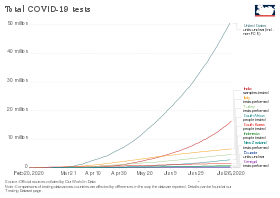Infectivity

Infectivity is indicated by the basic reproduction number (R0, pronounced "R naught") of the disease. SARS-CoV-2 is estimated to have an R0 of 2.2 to 2.5. This means that in a population where all individuals are susceptible to infection, each infected person is expected to infect 2.2 to 2.5 others in the absence of interventions. R0 can vary according factors such as geography, population demographics and density. In New York state R0 was estimated to be 3.4 to 3.8.
On average, an infected person begins showing symptoms five days after infection (the "incubation period") and can infect others beginning two to three days before that. One study reported that 44% of viral transmissions occur within this period. According to the CDC, a significant number of infected people who never show symptoms are nevertheless contagious. In vitro studies have not found replication-competent virus after 9 days from infection. The statistically estimated likelihood of recovering replication-competent virus approaches zero by 10 days.
Infectious virus has not been cultured from urine or reliably cultured from feces; these potential sources pose minimal if any risk of transmitting infection and any risk can be sufficiently mitigated by good hand hygiene.
Patterns and duration of illness and infectivity have not been fully described. However, available data indicate that SARS-CoV-2 RNA shedding in upper respiratory specimens declines after symptom onset. At 10 days recovery of replication-competent virus in viral culture (as a proxy of the presence of infectious virus) approaches zero. Although patients may produce PCR-positive specimens for up to six weeks, it remains unknown whether these samples hold infectious virus. After clinical recovery, many patients do not continue to shed. Among recovered patients with detectable RNA in upper respiratory specimens, concentrations after three days are generally below levels where virus has been reliably cultured. These data were generated from adults across a variety of age groups and with varying severity of illness. Data from children and infants were not available.
Comments
Post a Comment